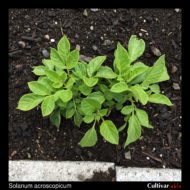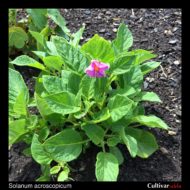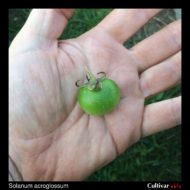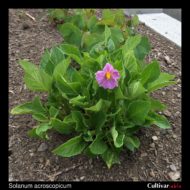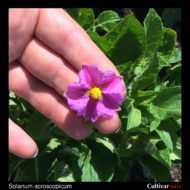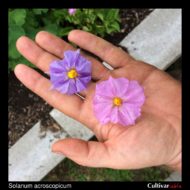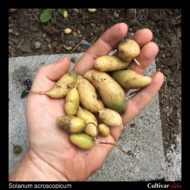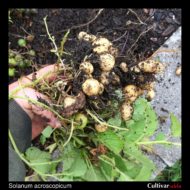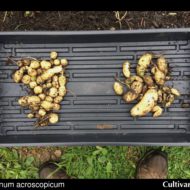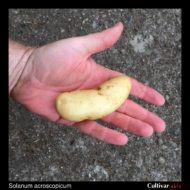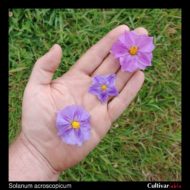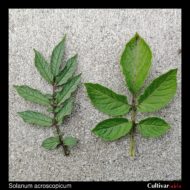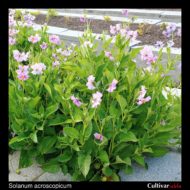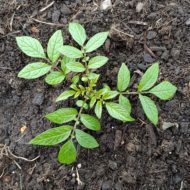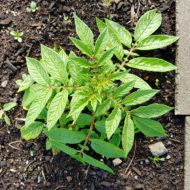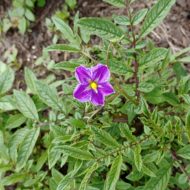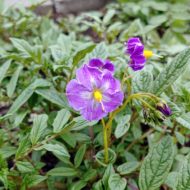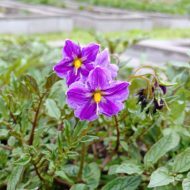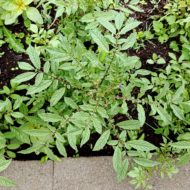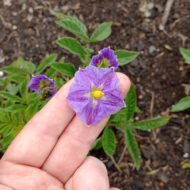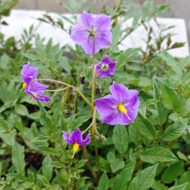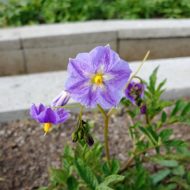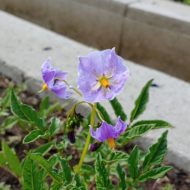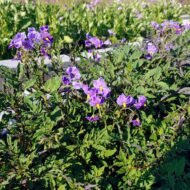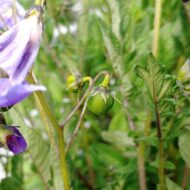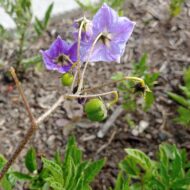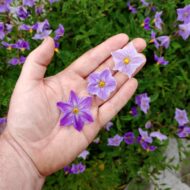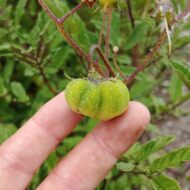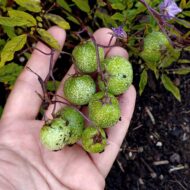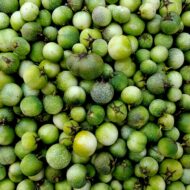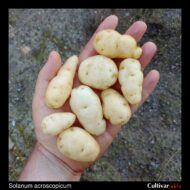Solanum acroscopicum
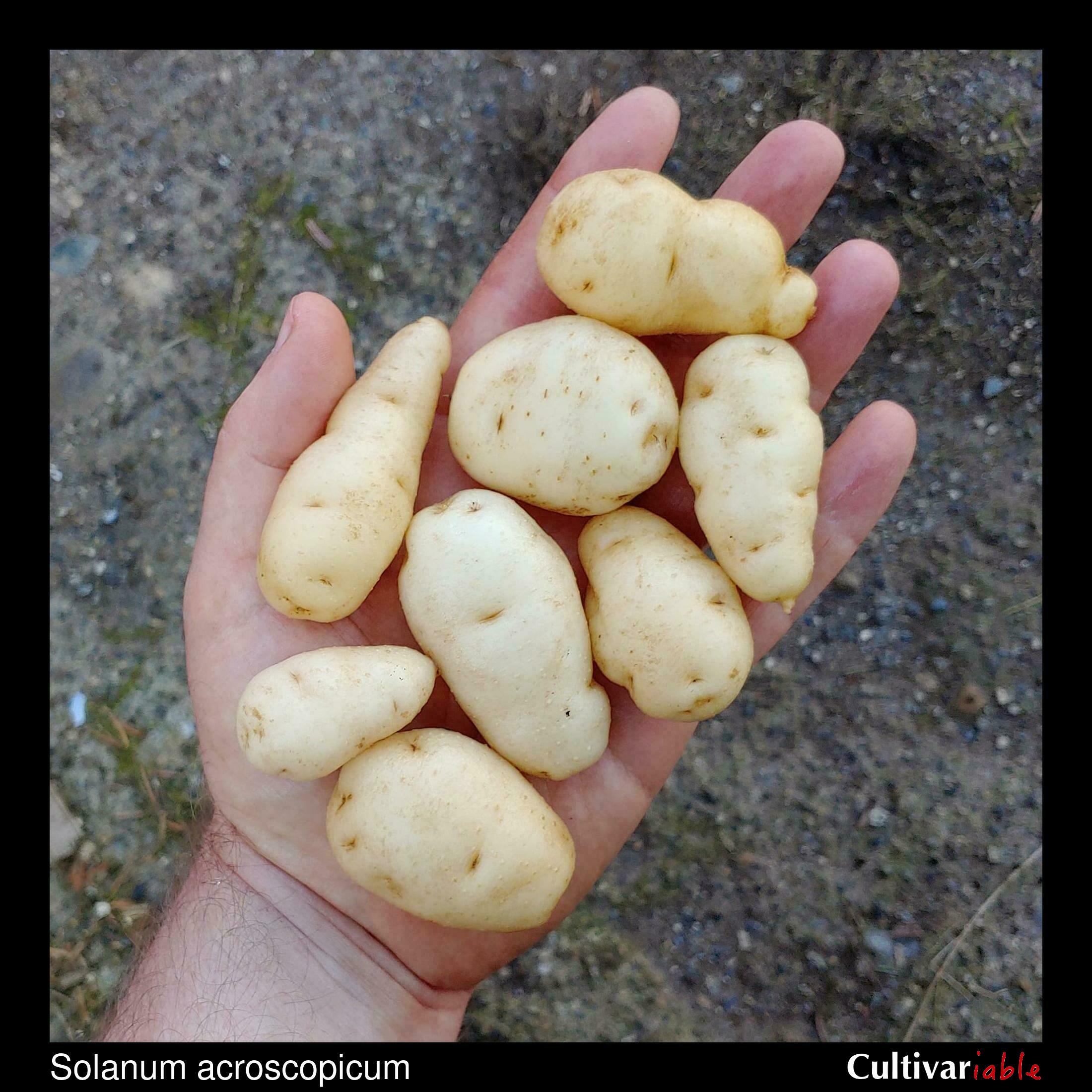
| Common Names | Papa del zorro |
| Code | acs |
| Synonyms | S. lopez-camarenae |
| Clade | 3 |
| Series | Tuberosa |
| Ploidy | Diploid (2x), Tetraploid (4x) |
| EBN | 2 |
| Tuberization Photoperiod | Short Day |
| Self-compatibility | No |
| Nuclear Genome | P |
| Cytoplasmic Genome | M, W |
| Citation | Ochoa: Agronomía (Lima) 18: 130. 1953. |
Description
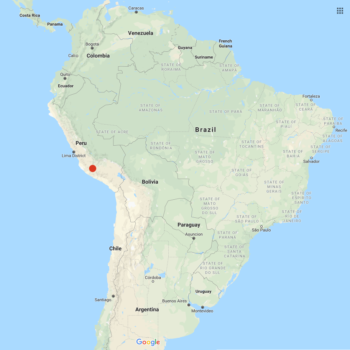
Solanum acroscopicum is a Peruvian diploid species. Plants range mostly 1 to 2 feet tall with long, narrow leaves. Stolons grow as long as 32 inches (80 cm). Tubers are white to tan, long and narrow, reaching as much as three inches in length, but usually much less. Unlike most species in clade 3, which have moniliform tubers, this species has terminal tubers. Flowers are light blue to purple. This is a high elevation species that typically ranges from about 9800 to 12800 feet.
The specific epithet, acroscopicum, refers to the tendency of the leaflets to point toward the terminal leaflet or apex. It is formed from the Latin prefix “acro,” for “high,” and “scopos,” for “target.” While there is no completely standardized pronunciation for scientific names, the most common way to pronounce this species is probably so-LAY-num ack-ro-SCO-pi-cum.
A tetraploid accession of this species differs in having short stolons, short day tuberization, larger leaves and flowers, and shorter internodes. White flowers also appear occasionally in the tetraploids. More information is reported below.
Jarvis (2008) predicts that this species will lose 95% of its present range by 2055 due to climate change, most likely entailing a critical loss of genetic diversity.
Resistances
Vega (1995) found that this species is about as frost tolerant as domesticated potato. Hijmans (2003) found that about 50% of plants of this species survived a frost of -5 C and Luthra (2007) found a similar rate of survival for a frost of unspecified temperature.
MacKinnon (1962) found that survival of aphids on this species was low and that potato leafroll virus was not transmitted by infected aphids.
I have observed strong resistance to late blight in diploid accessions of this species but no resistance in the tetraploid accession.
| Condition | Type | Level of Resistance | Source |
|---|---|---|---|
| Alternaria solani (Early Blight) | Fungus | Resistant | Prasad 1980 |
| Leptinotarsa decemlineata (Colorado Potato Beetle) | Invertebrate | Resistant | Kiru 2008 |
| Meloidogyne spp. (Root Knot Nematode) | Invertebrate | Somewhat Resistant | Nirula 1967 |
| Pectobacterium carotovorum (Blackleg/Soft Rot) | Bacterium | Low resistance | Lojkowska 1989 |
| Phytophthora infestans (Late Blight) | Fungus | Somewhat Resistant | de Galarreta 1998 |
| Phytophthora infestans (Late Blight) | Fungus | Not Resistant | Tiwari 2015 |
| Potato Leafroll Virus (PLRV) | Virus | Resistant | de Galarreta 1998 |
| Potato Virus M (PVM) | Virus | Not Resistant | de Galarreta 1998 |
| Potato Virus S (PVS) | Virus | Not Resistant | de Galarreta 1998 |
| Potato Virus Y (PVY) | Virus | Not Resistant | de Galarreta 1998 |
| Potato Virus Y (PVY), C Strain | Virus | Resistant | Takacs 1999 |
| Potato Virus Y (PVY), NTN Strain | Virus | Resistant | Takacs 2001 |
| Synchytrium endobioticum (Wart) | Fungus | Some with immunity | Nagaich 1980 |
| Tobacco Mosaic Virus (TMV) | Virus | Not Resistant | Horvath 1985 |
Glykoalkaloid content
I have found no accounts of glycoalkaloid content for this species, other than a brief mention that glycoalkaloids are low (Kiru 2008). I tasted freshly harvested tubers and found them pleasant and nearly indistinguishable from domesticated potato. Among the diploids, most have some mild sourness to the skin and perhaps a third have a bit of sourness in the flesh. With those odds, it is very easy to select palatable varieties. This is probably good evidence that the TGA content is at least close to the safety zone, but there is no guarantee that this species does not contain other toxic components. In the tetraploids, I was surprised to find that even tubers that were partly exposed and greened had no detectable bitterness. I have now eaten several large portions of my selections from this species with no apparent ill effects. While I wouldn’t feel comfortable declaring it completely safe to eat, I think it is very close to that.
Images
Cultivation
I have found seeds of this species easy to germinate using the standard conditions for S. tuberosum. The USDA Potato Introduction Station found that an accession of this species stored at near freezing temperature for 17 years retained 100% germination (Towill 1982).
Tetraploid of this species (or at least those accessions that I have grown) tuberize under long day conditions and many of the tubers are clustered tightly around the base of the plant. Spring sown plants began to senesce in August and yielded about 8 ounces of tubers per plant.
Tuber dormancy appears to last about six to eight weeks, so this species should be treated like low dormancy domesticated diploids in storage.
Accessions Evaluated
The following accessions were examined to prepare this profile. I have evaluated 4/4 accessions currently available from the US Potato Genebank.
PI 230495
Excellent germination and strong seedling growth, greatly outpacing the diploid accessions. Seedlings vary considerably in form, some with green stems, some with purple, some glabrous, some pubescent, some with lots of apex-directed leaflets, and some with fewer leaflets, appearing similar to domesticated potato seedlings. Flowers are much larger than those of the diploid accessions and pink, light blue, or white.
This is the first accession of this species that I grew and it turned out to have a lot of unexpected traits. I noticed, after growing it, that the US Potato Genebank lists this accession as having 48 chromosomes, when it should be diploid with 24 chromosomes, as is the case for all collections from the wild. Seedlings from this accession formed tubers under long day conditions, had very short stolons, and apparently very low glycoalkaloid content. Beyond that, although the leaf architecture has similarities to S. acroscopicum, the leaves are larger and broader, the internodes are shorter, and the flowers much larger when compared to the diploid accessions. Most of the plants also appear to be self-compatible. These sorts of changes are common with polyploidy and are similar to those seen between domesticated diploid and tetraploid potatoes.
The plants are very obviously different in form from any domesticated potato that I have seen. They are even more different than the accessions of diploid S. acroscopicum that I have grown. That makes this accession a bit of a mystery. The most obvious explanation, and the one that I initially accepted, is that this is a tetraploid accession and the differences in morphology are simply due to increased ploidy. This explanation became unsatisfying with further experience and research.
The accession was collected by Carlos Ochoa in 1953 in Chivateria, Tacna, Peru and designated Ochoa 2043. Ochoa 2043 is an isotype, a collection of the same plant from which the original species description was made. That makes it highly unlikely that it was originally tetraploid, since the species has always been described as diploid and Ochoa’s descriptions and drawings are not consistent with the tetraploid form that I observed. I contacted the gene bank to see if they knew anything more and they told me that Hawkes reported it as tetraploid and off type in 1969 and recommended discarding the accession. So, it has been tetraploid for at least 50 years. I’m sure glad that they didn’t discard it, because it has produced some very interesting progeny. However, the genebank probably should reclassify this to an unidentified Solanum species, since at least three papers have used it as a representative for S. acroscopicum in genetic analyses, a purpose for which it appears to be unsuitable.
The exact nature of this accession remains unknown, but I have come to suspect that it is most likely a hybrid between S. acroscopicum and S. tuberosum.
I considered three possibilities to explain the unusual combination of traits found in this accession:
1. This accession is misidentified and is actually a domesticated potato.
I tend to discount this possibility because the plants differ very obviously in form from domesticated potatoes, however, domesticated potatoes have a lot of diversity in form. I can’t rule out the possibility that this is just an unusual potato phenotype that I haven’t seen before, but there is some evidence against it, at least if I am interpreting it correctly. Three papers report the results of genetic markers run on this accession. In the first paper (Miller 1999), a combined RFLP and RAPD analysis, this accession grouped closely with the S. acroscopicum diploid accession PI 365314 and distantly to any S. tuberosum group. In the second paper (Raker (2002), an SSR analysis, this accession grouped most closely with the S. candolleanum accessions PI 442696 and PI 210055, and the S. tuberosum accession PI 473267, but this paper was focused on the tuberosum group and may have lacked a large enough number of wild species to position this accession with sufficient resolution. In the third paper (Spooner 2005), a large scale AFLP study, this accession grouped most closely to the S. tuberosum accession PI 281038 and quite distantly from the diploid S. acroscopicum accessions. In this study, the S. candolleanum accessions PI 442696 and PI 210055 also appear and are grouped together, but are placed distantly from PI 230495.
If the seed lot used in the 1999 study ran out and was replaced before the 2002 and 2006 studies, that would open up the possibility that a mistake was made at the genebank. On the other hand, as noted above, Hawkes declared that it was off type 30 years before the 1999 study. That doesn’t square with a more recent mistake. If the same seed lot was used in all three studies, then this suggests that some contribution from S. acroscopicum is present.
It is also worth considering the limits of these marker trees, a matter in which I have limited knowledge and no experience. I get a sense of blind men feeling the different parts of the elephant from the results of these studies. One set of markers may be seeing the domesticated and the other the wild within the same potato. S. acroscopicum was not the focus of these studies and was included in pretty small groups of wild potatoes in two of them. The best fit is found in each case based upon the included accessions and the number of markers is fairly small in two of these studies. Results could change based upon the inclusion of different accessions. Relative position in such a tree should not be confused with absolute positioning in a theoretical complete potato family tree.
2. This is a pure S. acroscopicum tetraploid.
I still don’t consider this possibility ruled out, but the fact that Raker (2002) and Spooner (2005) found that this accession grouped with Andean domesticated potatoes suggests that it is unlikely to be a pure S. acroscopicum tetraploid. I also have intuitive doubts that simple polyploidization would be enough to explain the abundance of domesticated traits in this accession.
3. This is a hybrid of S. acroscopicum and a domesticated potato.
This now seems like the most likely explanation. It is reasonably clear that this accession has not always been a hybrid. PI 230495 is Ochoa 2043. The Ochoa 2043 isotype is consistent with the diploid features of this species. That means that it must have become tetraploid at some point following the original collection, or perhaps the seeds collected from that original plant produced tetraploid progeny from a natural outcrossing. It seems intuitively more likely that the hybridization would have occurred during seed bulking at the genebank but, on the other hand, the other domesticated and S. candolleanum accessions that it has grouped with in several studies are Peruvian. If contamination occurred at the genebank, it could have been from any potato and Peruvian accessions are not the majority. If contamination occurred prior to collection or in an early round of seed bulking, the self-compatible tetraploids could easily have become overrepresented in later bulkings.
Taken together, the three marker trees discussed above suggest to me that PI 230495 may be a hybrid between S. acroscopicum and an Andigenum type domesticated potato. This is a true seed accession, so if it is a hybrid, each seedling will have a different expression of parental genetics, with consequently different placement on these genetic trees. The hybrid scenario makes a lot of sense to me, as it seems like a surprisingly large number of domesticated traits appeared that are absent from the S. acroscopicum diploids that I have evaluated.
As a tetraploid hybrid of S. acroscopicum and S. tuberosum, the A and P genomes would be mixed and the only likely configuration would be AAPP. Other mixed AP polyploids appear to have retained the same proportions over time, which suggests that inheritance is disomic. In that case, the only probable gametes would be AP, which means that self-pollinations would always result in AAPP progeny
Other predictions that could be checked: The cytoplasmic inheritance would almost certainly have been from S. acroscopicum, since it is hard to imagine a scenario under which seeds would have been collected from a domesticated potato to include in this accession. S. acroscopicum is known to have both the M and W cytoplasmic genomes, both of which are relatively uncommon in domesticated potatoes. The hybrid would most likely be 4EBN, given that both parents are 2EBN when diploid and it does appear to behave as 4EBN in crosses.
I have used self-pollinated progeny of PI 230495 seedlings successfully in crosses with tetraploid S. tuberosum. The seedlings appear to be tetraploid by guard cell counts. I assume that they would be AAAP, which leads me to believe that the next generation of crosses would have fertility problems, since the P genome is unpaired. I have not actually observed any fertility problems though. This may be evidence against the hybrid hypothesis or may simply be a problem with my expectations. Results from wild-domesticated hybrids are not easy to predict. It is also possible that the unpaired, “extra” A and P chromosome sets aren’t able to form gametes and that only AA gametes are produced.
PI 365314
Good germination and moderately strong seedling growth. Stems light to dark purple. Flowers mostly dark blue, some light. Collected in Arequipa, Peru, at the same site as PI 365315. Hosaka (2012) found that this accession has W type cytoplasm. It is pretty interesting that these two very similar accessions collected in the same area have different cytoplasm types. Largest tubers of the three diploid accessions.
PI 365315
Fair germination, although irregular, and slow seedling growth. Stems light to dark purple. Flowers light blue. This appears to be the most phenotypically diverse of the three diploid accessions. Collected in Arequipa, Peru, at the same site as PI 365315. Hosaka (2012) found that this accession has M type cytoplasm.
PI 607891
Excellent germination and strong seedling growth. All seedlings have dark purple stems. Flowers dark blue. Collected in Tacna, Peru, near to the collection site of PI 230495. CIP public domain MTA.
Breeding
Crosses with S. tuberosum
| Female | Male | Berry Set |
Seed Set | Germ | Ploidy | Source |
|---|---|---|---|---|---|---|
| S. tuberosum 4x | S. acroscopicum 2x | Low | Low | Jackson (1999) | ||
| S. acroscopicum 2x | S. tuberosum 4x | None | None | Jackson (1999) |
Crosses with other species
Jackson (1999) found 0-12% 2n pollen for varieties of this species.
| Female | Male | Berry Set |
Seed Set | Germ | Ploidy | Source |
|---|---|---|---|---|---|---|
References
Solanum acroscopicum at Solanaceae Source

